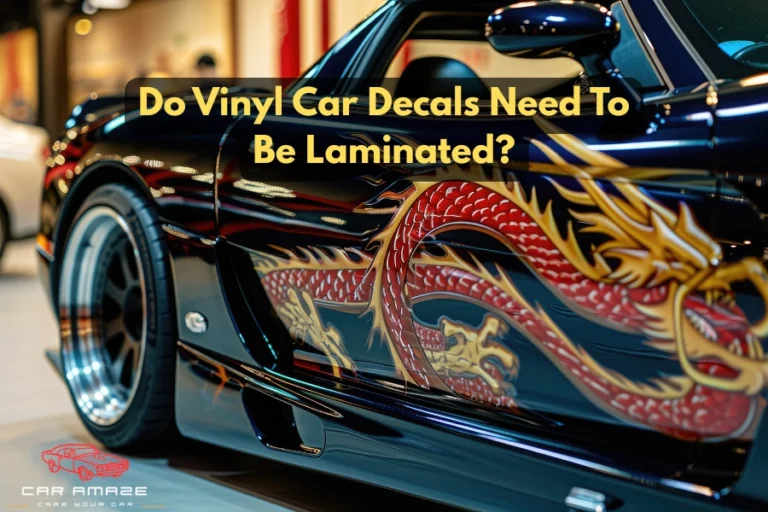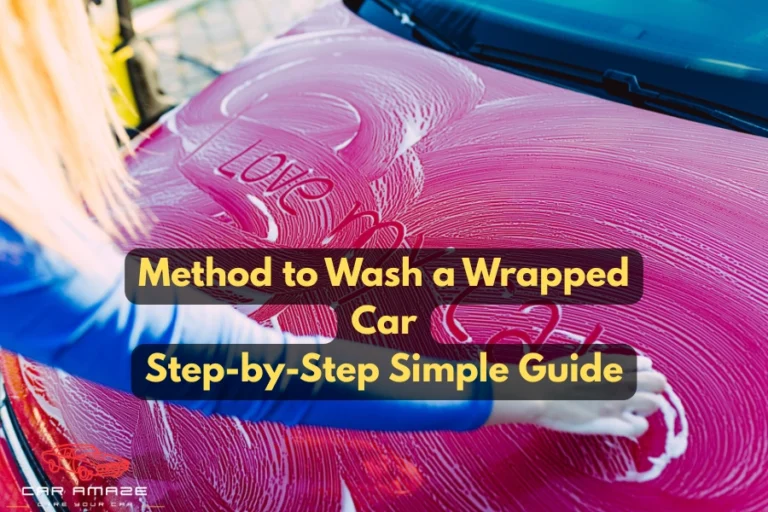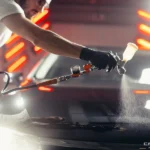How much paint to paint a car? The detailed guide on paint
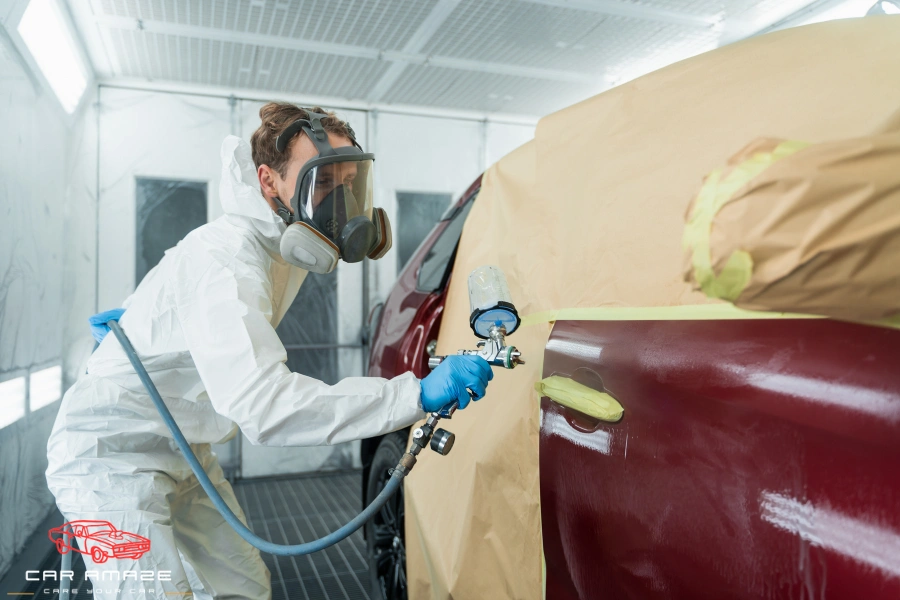
Painting a car can enhance its look and value, but it is essential to do it correctly. Whether you want to refresh the paint or change the color of the paint, you must apply the right amount of coats. This detailed guide will help you determine how much paint to paint a car. From calculating the right amount of paint to the best techniques for painting, you will learn everything in detail.
Quick Answer: Amount of Paint for a Car 📄
On average, painting a car requires 2–3 gallons for small cars and 3–4 gallons for larger cars, plus primer and clear coat. The exact amount depends on the car’s size, paint type, number of coats, and painter’s skill.
Paint Calculation Formula: Paint needed = (Car surface area × Extra paint for mistakes × Number of coats) ÷ Paint coverage per gallon
Example: If your car’s surface area is 220 sq ft, with 2 coats, an extra 20% paint for mistakes, and paint coverage of 160 sq ft per gallon → (220 × 1.2 × 2) ÷ 160 = 3.3 gallons of paint
Table of contents
- How Much Paint Does It Take to Paint a Car?
- Calculating the Amount of Paint to Paint a Car
- Formula to calculate the amount of paint to paint a car
- Essential car painting supplies
- Factors Influencing Car Paint Quantity
- Tips for car paint measurement
- How much paint to paint a car?
- Efficient car painting techniques
- Conclusion
- FAQs
How Much Paint Does It Take to Paint a Car?
There are several steps involved in calculating the right amount of paint for your car. First, measure the total surface area of every part of your car, including the roof, doors, fenders, hood, and trunk. Then, figure out whether you want to apply a few coats to refresh the original paint or multiple coats to paint the car from scratch. Typically, a small car requires about 2-3 gallons of paint, while a larger vehicle might need 3-4 gallons.
Calculating the Amount of Paint to Paint a Car
Calculating the surface area and amount of paint required for each part is necessary to get an accurate estimate. To determine how much paint to paint a car, estimate the surface and do the calculations accordingly. Here is the breakdown of the car surface area, the paint required for each part, and the formula to calculate the car paint amount:
Surface area of individual car parts
While exact measurements can vary, here are the approximate surface areas of each part of an average-sized sedan car:
- Hood surface area: The average area of a hood is 20–25 sq ft (1.9–2.3 m²). For SUVs, it can exceed 25.
- Roof surface area: The roof has a surface area of 22–30 sq ft (2.0–2.8 m²).
- Door surface area: Average size of 1 door is 15–18 sq ft (1.4–1.7 m²). For a total of 4 doors, the area will be approximately 64 sq ft.
- Fender surface area: The area of one fender is 6–8 sq ft (0.55–0.75 m²). So, the total surface area for two fenders will be around 14 sq ft.
- Bumper surface area: The average surface area of a bumper is around 12 sq ft. This way the total surface area for both fenders of the car will be 24 sq ft.
- Trunk lid surface area: The average area of the trunk lid of a sedan car is 14 sq ft.
- Side mirrors: There are two side mirrors in the car with an average area of 2 sq ft.
- Pillars: Pillars are vertical sections framing the windshield, doors, and rear window. The average area of 1 pillar is around 2.5 sq ft. So the area for a total of four pillars will be around 10 sq ft.
- Rockets or side skirts: These are the paintable panels below the doors on both sides. For both sides of the car, the total surface area for these is around 10 sq ft.
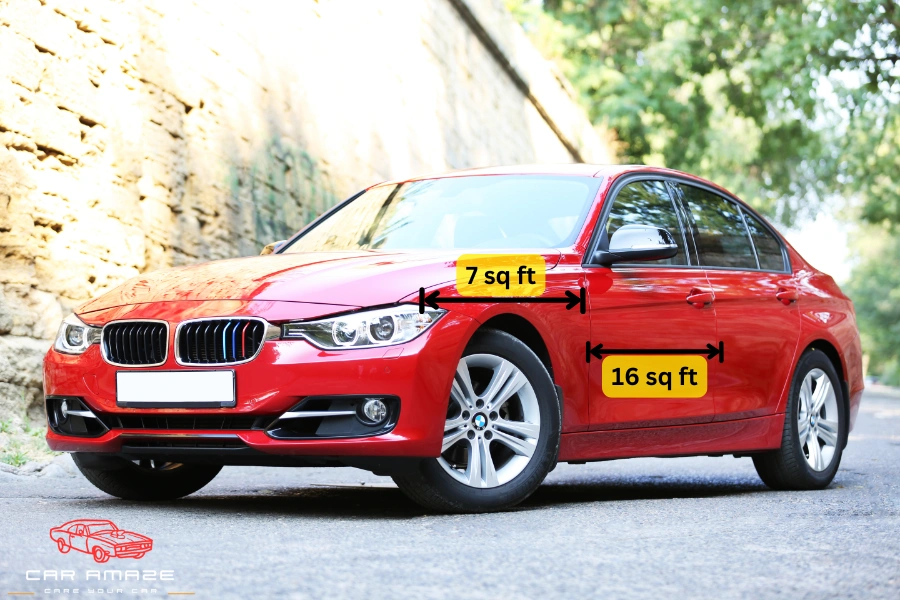
Estimating total paintable surface area
When we sum up all these surface areas, the total area comes to 193 square feet. As not all sedan cars have the same size and surface area to paint, we can consider the total surface area to be around 200 square feet or 18.6 square meters.
Paint coverage on a car per gallon
Paint coverage means the amount of area that a specific quantity of paint can cover. Different types of paint have different coverage on a vehicle per gallon. The four common types of paint are single-stage paint, basecoat paint, clear coat, and primer. The coverage for each of these types of paint is listed below:
- Single-Stage Paints: 120–140 sq ft/gal.
- Basecoat Paints: 150–180 sq ft/gal.
- Clearcoats: 140–160 sq ft/gal.
- Primers: 200–250 sq ft/gal.
Formula to calculate the amount of paint to paint a car
The formula for calculating the amount of paint involves four variables, including total surface area, number of coats, paint coverage, and overage factor (extra for mistakes). Based on these variables, the formula to find out the amount of paint to paint a car is:
Car paint amount = {(Surface Area x Overage Factor) x Number of Coats}/Paint CoverageApplying formula to know how much paint to paint a car
Let’s apply the paint calculation formula for the doors of the car to help you get a better idea.
Calculating paint amount for car doors
The total surface area for the door is 64 sq ft. Moreover, we apply the base coat with coverage of 160 sq ft/gal, use 2 coats, and keep the overage factor at 1.2 (20%). Based on these parameters, the amount of paint to paint the doors of the vehicle is:
Paint amount for car doors = (64 x 1.2 x 2)/160 = 0.96 gallonsCalculating paint amount for whole car
Similarly, the amount of paint required for a whole car using a base coat will be 3 gallons. Here is the formula to calculate the amount of paint:
Paint required for a whole sedan car = (200s x 1.2 x 2)/160 = 3 gallons.And if we use the premium coat with 200 sq ft/gal paint coverage, the amount of paint for the whole vehicle will be 2.4 gallons. Here is the formula for calculating the amount for the premium:
Premium paint amount for car = (200s x 1.2 x 2)/200 = 2.4 gallons.
Important note about paint amount calculation
Please remember that these are the most accurate estimates for the paint amount. The calculation varies because different cars have different surface areas. Moreover, the skill level of the painter also affects the amount of paint used. The skill level of a painter matters whether he is painting the whole vehicle or just painting to remove paint scuff from the car. For precise calculations, measure each part of your car accurately.
Essential car painting supplies
How much paint does it take to paint a car? The answer depends on the vehicle size and the purpose of the painting. Before starting the painting, determine these two factors and gather the required painting supplies. Some important paint supplies include vehicle paint, premier, clear coat, sandpaper, masking tape, a spray gun, and some other hardware tools. Having these supplies ready will make the painting process smoother and help you paint the vehicle perfectly.
Factors Influencing Car Paint Quantity
The amount of paint required to paint an entire vehicle depends on several factors. Here is a description of the prominent factors that help you decide how much paint to paint a car:
Surface Area of the Car
The surface area of the vehicle plays a key role in determining the amount of paint needed. Large cars have more surface area and require more paint, whereas small cars have less surface area and require less paint. Measure the dimensions and areas of each side of the vehicle to get an accurate estimate of paint quantity. If you are painting the car just to change color or design, remember that wrapping a car is cheaper than painting the whole car again.
Type and Color of Paint
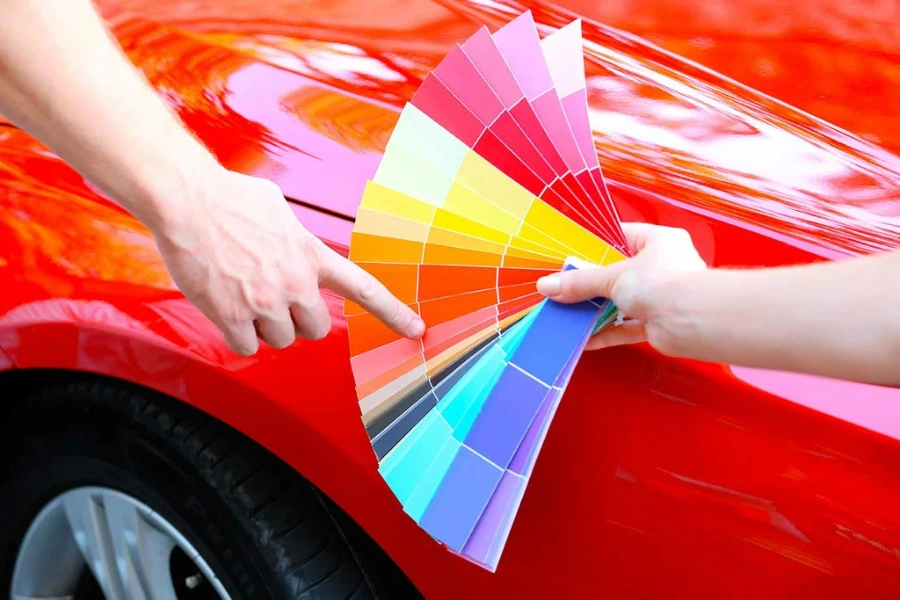
Different types and colors of paint can affect the amount needed. If you choose a light color, you will need more paint because light colors require more coats. In comparison, dark colors can cover the area in fewer coats and require less paint. This table showcases some of the common paint types and suitable surfaces for them.
| Type of paint | Description | Suitable surface |
| Acrylic Lacquer | Easy to apply, high gloss finish, not very durable. | Metal, plastic, fiberglass |
| Acrylic Enamel | More durable than lacquer, glossy finish, longer drying time. | Metal, plastic, fiberglass |
| Urethane | Very durable, resistant to chips and scratches, more difficult to apply. | Metal, plastic, fiberglass |
| Metallic Paint | Contains metal flakes, gives a shiny, reflective finish. | Metal, plastic, fiberglass |
| Pearlescent Paint | Contains ceramic crystals, creates a shimmering effect. | Metal, plastic, fiberglass |
| Matte Finish | Non-glossy, flat finish, requires special maintenance. | Metal, plastic, fiberglass |
| Basecoat/Clearcoat | Two-step process: basecoat for color, clearcoat for protection and shine. | Metal, plastic, fiberglass |
Primer Application and Quality
Aside from the paint, the quantity of primer also varies based on the car’s condition. The primer is essential because it helps the paint adhere better to the car’s surface. If the car’s surface is in good condition, you will require less primer and paint. Using a good-quality primer is essential for a smooth and long-lasting paint job.
Paint Thickness and Layers
Another factor that determines the amount of paint is the thickness of the paint and the number of layers required. To avoid wasting paint and achieve the best results, apply multiple thin layers instead of one thick layer. If your car’s paint is damaged by hail, determine whether it is worth fixing the hail damage. Typically, apply three coats: the first for the base, the second for color, and the third for the clear coat.
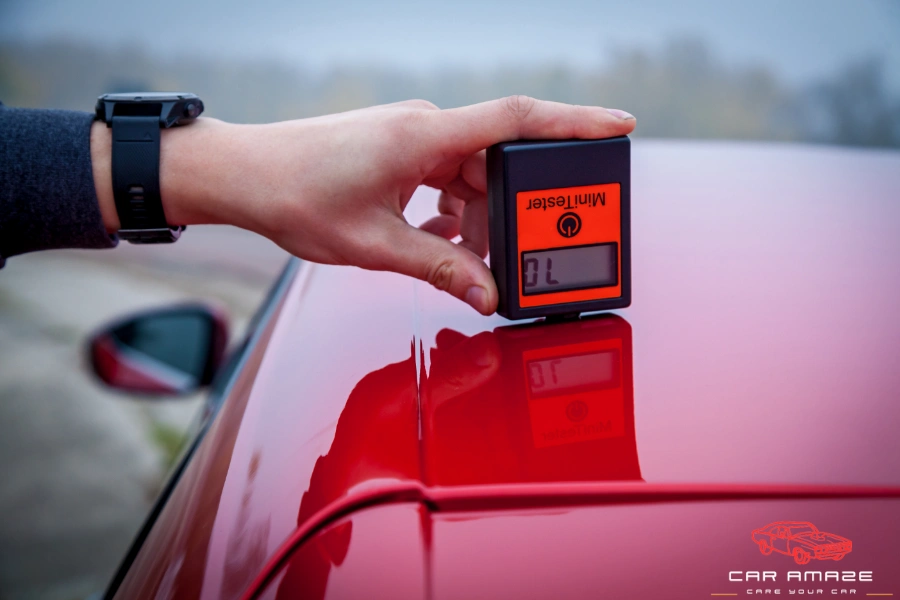
Environmental Conditions
Weather conditions also influence the quality and quantity of paint. The temperature and humidity levels in the atmosphere affect how paint adheres and dries. For example, high humidity can increase the drying time, and you may need more paint for a better finish. Before applying the paint, read the manufacturer’s instructions to achieve better results without wasting paint.
Skill of the Painter
The skill level of the painter also affects the amount of paint used on the vehicle. Experienced painters can produce good finishes without using an excess amount of paint. Therefore, avoid hiring cheap and unskilled painters to avoid wasting paint on your vehicle. All these factors can help you calculate the extent of painting work and time required to paint a car.
Tips for car paint measurement
When measuring the vehicle paint quantity, it is a wise decision to overestimate slightly. Calculate the amount of paint for each surface and identify the area that requires more attention. With this strategy, the paint will not get short during the painting process, and you will get the perfect finish. If you need assistance with estimating other materials for a car, such as wrap, check out my guide on how much wrap you need for your car.
How much paint to paint a car?
The exact amount of paint is different for all cars based on their size. Small and medium-sized cars usually require 3 gallons of topcoat, 1 gallon of primer, and 2–3 gallons of clear coat. On the other hand, large cars require 4 gallons of topcoat, 1.5 gallons of primer, and 3–4 gallons of clear coat.
Efficient car painting techniques
Hopefully, you have learned about the steps to determine how much paint to paint a vehicle. Now let’s discuss some of the efficient techniques for painting a car:
Proper surface preparation
The first step before starting the painting job is proper surface preparation. Clean the surface of the car thoroughly to remove dirt, grease, and wax. After that, sand the surface to remove roughness and produce a smooth base for premier.
Spray gun techniques
Using the spray gun properly can make a big difference in the final result. Hold the spray gun about 6-8 inches from the surface and move it smoothly. If you are a beginner and not familiar with using a spray gun, do some practice on the cardboard.
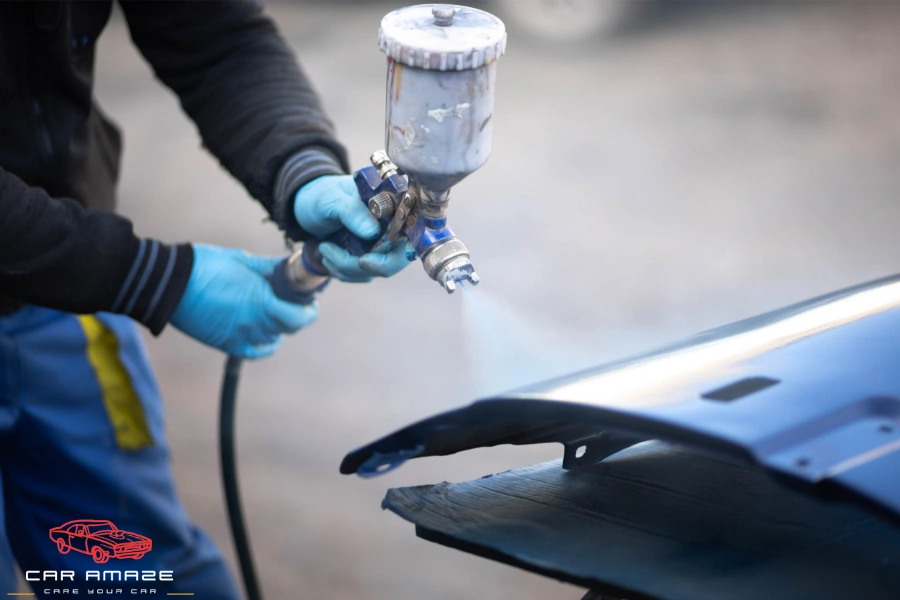
Paint mixing and consistency
Mixing the paint and other solutions properly also makes a big difference in the quality. You must follow the manufacturer’s guide about the quantity of each solution and mixing method. The perfect mixture will be sprayed more evenly and produce a more smooth finish.
Apply thin coats
Apply thin coats because it eliminates the chances of running and drips on the car’s surface. You should apply a single coat at a time and let it dry before applying another coat. This technique will produce a smoother finish, and the color will be more accurate. Moreover, thin coats dry faster, which speeds up the process and improves efficiency.
Drying and curing process
The drying time varies depending on the type of paint and environmental conditions. However, after applying all the coats, let the paint cure for around 1 day. It will make sure that the paint is fully dry and strongly adheres to the car’s surface.
Conclusion
Painting a car is a critical process that requires careful planning and preparation. Determine how much paint to paint a car and apply the paint with the right technique. Always buy high-quality materials and follow the manufacturer’s guide to use each material in the right amount. Remember to prepare the surface properly, apply thin coats, and allow adequate drying time.
FAQs
How much paint does it take to paint a car?
The exact quantity of paint depends on the size and condition of the car. In general, you will require 1-2 gallons for a small car, 2-3 gallons for a medium car, and 3-4 gallons for a large car.
Do I need a primer before painting my car?
Yes, the premier is essential before painting a car because it helps the paint adhere better. Moreover, it protects the car body from rust and improves the durability of the paint.
How many coats of paint should I apply?
You should apply three coats, including one base coat, one color coat, and one clear coat.
What type of paint is best for cars?
Urethane is the most durable, but acrylic lacquer and enamel are easier to apply. The best method is to choose the paint based on the car’s surface, your skill level, and your budget.
How long does it take for car paint to dry?
The drying time depends on three things: temperature, humidity, and the number of coats. If you apply multiple thin coats, the drying process will be quick, and if you apply a few thick coats, the drying process will be late.
